Welcome back to school. I hope everyone had a wonderful and relaxing holiday!!! This month,we will be doing a few book studies. We will be using four books that focus on winter.
The books we will be using as our shared reading are:
1.The Mitten by Jan Brett
http://www.hubbardscupboard.org/the_mitten.html
*We read this story using puppets, too! Students help act out the tale again using
the puppets. We discuss the sequence of events, especially the order of the
characters. Then each student is given a mitten-shaped booklet with blank pages.
Students glue the characters' pictures in order to retell the story.
2.Snowballs by Lois Ehlert
*Give students white paper and a collection of scraps (paper, fabric, yarn, twigs,
feathers, buttons, wrapping paper, etc.) to create their own versions of a snowman.
http://www.theschoolbell.com/Links/Snow/snow.html
3. The Snowy Day by Ezra Jack Keats
*After reading this classic, students create a torn paper winter scene. Then they write a caption describing it.
4.The Jacket I wear in the snow by Shirley Neitzel
*This is a great rebus story! The kids will want to read it again and again. As a response to this story, students are given a paper divided into 8 boxes. These incomplete words are in the boxes: _ittens, _ong _ohns, _acket, _carf, _oots, _weater, _loves, _ants. Students will complete the initial letter and illustrate in each box.
5.Froggy Gets Dressed by Jonathan London
*Kids LOVE Froggy books and this is a great one to act out. After reading the
story, students work in groups to make the winter clothes for a "life-sized"
Froggy. Then they label each article of clothing using transitional/conventional
spelling and meet together in the circle. Discuss/read each label (adding correct
spelling below if necessary). Then reread the story allowing students to dress
Froggy as the story goes. All these props can then be placed in the storytelling centre.
The Storytelling Center gives students the opportunity to retell stories we've read as a class, using props along with the book.
Props may include:*masks
*puppets
*flannelboard figures
*"trinkets"
*real props.
The Poems we will be learning this month are:
1.Snowman
A chubby little snowman
Had a carrot nose
Along came a bunny
And what do you suppose
That hungry little bunny
Looking for his lunch
Ate that little snowman’s nose
Nibble, nibble, crunch
2.Snowflake
Dance like snowflakes, Dance like snowflakes
In the air, in the air
Whirling, whirling, twirling, Whirling whirling twirling
To the ground, to the ground.
(tune: Where is Thumbkin?)
3.Im a little snowman
I’m a little snowman
Short and fat
Here are my buttons
Here is my hat
When the sun comes out
I cannot stay
Slowly I just melt away.
(tune: I’m a little teapot)
4.Chant:(one group says the bold, the other's respond)
Snow is hot
No its not
Yes it is
No it's not, snow's not hot
Yes it is, yes it is, snow is hot
Not its not. No its not. Snow's not hot.
The Letters we will be focusing on this month are:
Ii
I scream, you scream, we all scream for ice-cream!!
(children cheer and pretend to eat ice cream)
i-i-i (children make the sound of i)
Jj
Jumping jellybeans, jumping jellybeans, jumping jellybeans. (children jump up)
j-j-j (children make the sound of j)
Kk
K is for kindegarten, k-k-k
K is for kindergarten, k-k-k
K is for kindergarten, k-k-k
Ll
Lollipop, lollipop, oh lolli, lolli, lolli (children pretend to be eating a lollipop)
Lollipop, lollipop, oh lolli, lolli, lolli
l-l-l (children make the sound of l)
The Seniors will be focusing on the following high frequency words
I, a, and, the, like, see, went , to, go,my, me
Journal Topics:*In the winter, I can see....
*Draw a snowman.
*Draw snowflakes.
*What do you like to do in the winter?
Group Games and activities
1.Graph favorite winter activities.
2.Make hot chocolate with marshmallows after playing out in the cold one day.
3.After reading the book, Snowballs , I will be sending home 3 small paper plates stapled together and ask them to make them into snowmen as creatively as they can.

4. I trace one of the students and add winter clothes to it. The students color it and then we label it for picture and words. This goes with the book, The Jacket I Wear In The Snow.
These students are stacking cubes on mittens. Then they get to sneeze (just like the bear in "The Mitten") and blow the cubes down
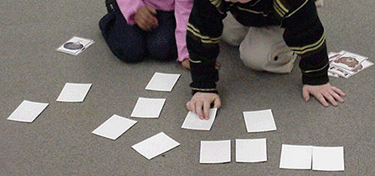
5. Concentration game with the characters from Jan Brett "the mitten"

6. Winter Clothes Relay- Have a race where the students have to put on the winter clothes and then run back.
7. We make puppets to act out the book "The Mitten". The kids’ usually enjoy acting out the story using a sheet to get under for the mitten.
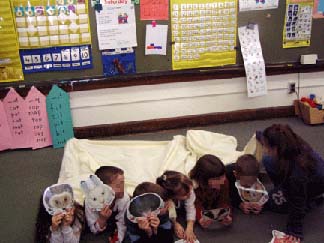
8. Put snow (shaving cream) on their tables/desks and have them write or draw winter words and winter scenes in it. I had them do picture and words in it and they loved it!!!
9. Make snowflakes out of wagon wheel pasta. We will be spray painting them white or gold.


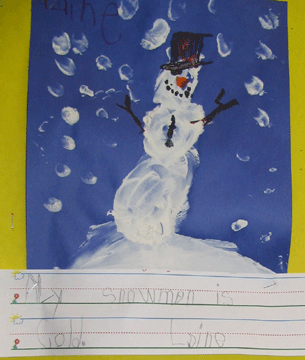
After these snowmen were fingerpainted the students wrote a sentence describing their snowman
11.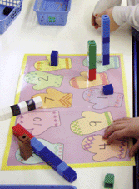

Lesson Introduction
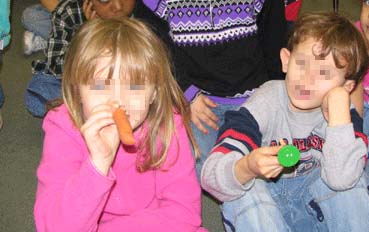
We have a "mystery bag" and we have to guess what was in it. Hmmm, it must have been a snowman that melted because the girl has the carrot nose and the boy has a button. This was our introduction to learning about the winter season
1.Snowball vocabulary game-We put high frequency words that we are learning, the letters we are learning and winter words on a piece of paper. We crumble them up into a ball and have a snow fight. When you get hit with a snowball, you have to open up the snowball and read out the word!!
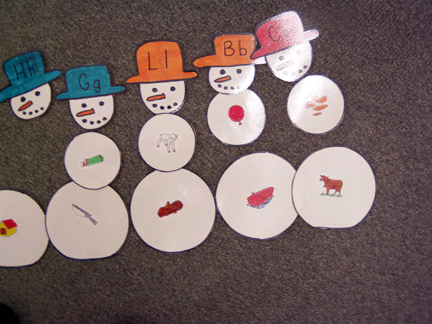
These snowman puzzles have the initial letter written on the hats. The children find a medium and large ball with pictures to match the beginning sound.
Math/Graphs:
*We do a yes/no graph to "Have you ever thrown a snowball or made a snowman?"
*We discuss symmetry and create symmetrical designs on a pair of paper mittens. They place the mittens side by side (left mitten on the left, right mitten on the right). What ever design they place on the left mitten, they must reproduce on the right.
Science
*We place a colored ice cube in a clear glass full of vegetable oil. At first the ice will
float, but as it begins to melt, little colored droplets will sink to the bottom. When the
ice is completely melted, there will be 2 distinct liquid levels.
*We also do an experiment to show the importance of wearing warm clothes during
cold weather. We fill 2 jars with hot water. One we "dress" in a sweater/jacket and
hat. The other "wears" a T-shirt. We place both jars outside for an hour or two.
Then we bring them inside, open them up, and test the water temperature.
*Everyday we bring in snow and put it in the water table and the children see how the snow melts once it is inside and warm.
Math/Graphs:
*We do a yes/no graph to "Have you ever thrown a snowball or made a snowman?"
*We discuss symmetry and create symmetrical designs on a pair of paper mittens. They place the mittens side by side (left mitten on the left, right mitten on the right). What ever design they place on the left mitten, they must reproduce on the right.
Science
*We place a colored ice cube in a clear glass full of vegetable oil. At first the ice will
float, but as it begins to melt, little colored droplets will sink to the bottom. When the
ice is completely melted, there will be 2 distinct liquid levels.
*We also do an experiment to show the importance of wearing warm clothes during
cold weather. We fill 2 jars with hot water. One we "dress" in a sweater/jacket and
hat. The other "wears" a T-shirt. We place both jars outside for an hour or two.
Then we bring them inside, open them up, and test the water temperature.
*Everyday we bring in snow and put it in the water table and the children see how the snow melts once it is inside and warm.











